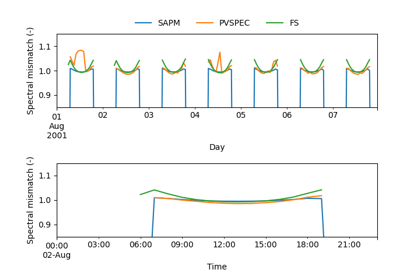pvlib.spectrum.spectral_factor_pvspec#
- pvlib.spectrum.spectral_factor_pvspec(airmass_absolute, clearsky_index, module_type=None, coefficients=None)[source]#
Estimate a technology-specific spectral mismatch modifier from absolute airmass and clear sky index using the PVSPEC model.
The PVSPEC spectral mismatch model includes the effects of cloud cover on the irradiance spectrum. Model coefficients are derived using spectral irradiance and other meteorological data from eight locations. Coefficients for six module types are available via the
module_typeparameter. More details on the model can be found in [1].- Parameters:
airmass_absolute (numeric) – absolute (pressure-adjusted) airmass. [unitless]
clearsky_index (numeric) – clear sky index. [unitless]
module_type (str, optional) –
One of the following PV technology strings from [1]:
'fs4-1'- First Solar series 4-1 and earlier CdTe module.'fs4-2'- First Solar series 4-2 and later CdTe module.'monosi'- anonymous monocrystalline Si module.'multisi'- anonymous multicrystalline Si module.'cigs'- anonymous copper indium gallium selenide module.'asi'- anonymous amorphous silicon module.
coefficients (array-like, optional) – user-defined coefficients, if not using one of the default coefficient sets via the
module_typeparameter.
- Returns:
mismatch (numeric) – spectral mismatch factor (unitless) which is multiplied with broadband irradiance reaching a module’s cells to estimate effective irradiance, i.e., the irradiance that is converted to electrical current.
Notes
The PVSPEC model parameterises the spectral mismatch factor as a function of absolute air mass and the clear sky index as follows:
\[M = a_1 k_c^{a_2} AM_a^{a_3},\]where \(M\) is the spectral mismatch factor, \(k_c\) is the clear sky index, \(AM_a\) is the absolute air mass, and \(a_1, a_2, a_3\) are module-specific coefficients. In the PVSPEC model publication, absolute air mass (denoted as \(AM\)) is estimated starting from the Kasten and Young relative air mass [2]. The clear sky index, which is the ratio of GHI to clear sky GHI, uses the ESRA model [3] to estimate the clear sky GHI with monthly Linke turbidity values from [4] as inputs.
References

